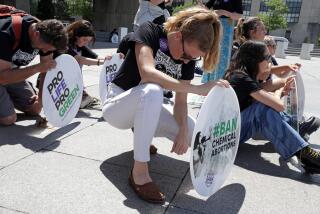When Protest Goes Too Far : Supreme Court gets clinic issue just right
- Share via
The abortion debate has generated nearly as much heat over the First Amendment, and its guarantee of free speech, as over the constitutionality of the medical procedure itself. Last week’s decision by the U.S. Supreme Court limiting protests near abortion clinics is a case in point.
By a 6-3 vote, the court held that judges and lawmakers can impose a buffer zone around a Florida abortion clinic and prevent protesters from picketing and chanting on the street and sidewalks in front of the facility and its parking lot. The decision, stemming from a long-running confrontation outside the clinic, was the court’s first detailed pronouncement on a protest issue that has arisen in scores of cases.
Leaders of Operation Rescue, an anti-abortion group, vowed to shut down the Florida clinic by conducting continuous protests. The clinic staff, complaining that the loud chanting during surgical hours was disruptive and constituted harassment, obtained a state court injunction. The broad injunction barred the chanting, created a 36-foot buffer zone outside the clinic and prohibited display of signs and photos that might disturb patients.
Abortion opponents challenged the injunction, citing First Amendment protections. But the high court decisively disagreed. Writing for the majority, Chief Justice William H. Rehnquist upheld key parts of the injunction, including the buffer zone and the bar on chanting. However, the ruling struck down the ban on signs and photos. In so doing, it clarified the law on this issue and drew a reasonable line between legitimate protest and illegal harassment.
Moreover, when read against the backdrop of other recent developments, the decision effectively disarms the most violent, disruptive abortion protesters. The message is consistent, whether from Congress in the form of the new Freedom of Access to Clinic Entrances Law; from the California Legislature, which passed a similar law late last year; from California’s appellate courts, upholding an injunction in Vallejo similar to that in Florida, or from the U.S. Supreme Court itself in narrower rulings handed down earlier this year: Peaceful protest is constitutional; disruptive or violent protest is not.
Although division remains among the justices over the constitutionality of abortion, the Supreme Court fortunately has begun to find its voice on the narrower, yet no less vital First Amendment question springing from this highly charged controversy.
More to Read
Get the L.A. Times Politics newsletter
Deeply reported insights into legislation, politics and policy from Sacramento, Washington and beyond. In your inbox twice per week.
You may occasionally receive promotional content from the Los Angeles Times.










